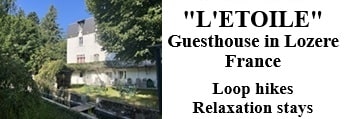59,4km bike tour at La Bastide-Puylaurent |
Take the D6 along the Allier via Les Huttes, Masmejean, the Château de Chabaleyret, Chabalier, Chasserades and Mirandol, then 1.1 km further on, turn left onto the D120 via L'Estampe and the D20 at the top of the Goulet mountain. This small road, facing Mont-Lozere, goes down to the D901 before Le Bleymard. Turn right and follow the Lot on the D901 to Bagnols-les-Bains via Saint Jean-du-Bleymard, the Château du Tournel and Saint Julien-du-Tournel. In Bagnols-les-Bains, cross the Lot and follow the D41 to Langlade via the Col de la Loubiere and Lanuejols. In Langlade, turn right onto the D25 to Mende via La Croix Neuve. Cross Mende via Boulevard Bourillon, Allee Piencourt, Pont de Berliere which crosses the Lot, then turn left at the roundabout to the station (Train timetables).

20,5km - 25km - 27,7km - 30km - 35,2km - 37km - 41,5km - 44km - 48,4km - 57,5km - 59,4km - 60km - 60,5km - 69km - 70km - 76,8km - 77km - 81km - 90km - 95,7km
Google Maps - Google Earth - GPX








Distance: 59.4km. Maximum altitude: 1475m. Minimum altitude: 710m. Cumulative elevation gain: 1193m.
IGN maps: Mende (2638E). La Bastide-Puylaurent (2738E). Le Bleymard (2738O). Mont Lozere Florac PN des Cevennes (2739OT). Largentiere la Bastide-Puylaurent Vivarais Cevenol (2838OT).
Print the route - Electric bike rental
To the southwest of Chasserades stood the castle of Mirandol, whose name clearly indicates the wide view. It was the seat of an important lordship (one of the twelve lordships or manor houses of Gevaudan). In the Romanesque period, it was held by the "ancient knighthood of Naves". Guillaume de Naves was in 1207 parier of La Garde-Guerin. Guerin de Naves, lord of Mirandol, witnessed in 1267 a homage paid to Guigues, baron of Tournel. A little further west, by the small tarmac road marked with granite crosses, we arrive at Saint Frezal d'Albuges. The train that connects Mende to La Bastide-Puylaurent via Allenc and Belvezet always stops at the small station which is about 1km from Chasserades. The line is often covered by snowdrifts in winter, protective tunnels had to be built. It is an excellent means of transport, inexpensive, very pleasant and unique in France. You can also take your bike on the train. To stop, you must signal your presence on the station platform with a big wave. The Mirandol viaduct is very impressive; it overlooks the Chassezac river which already takes the form of a small canyon and which further towards La Garde-Guerin will transform into imposing Gorges. (See the Gorges du Chassezac). The Chassezac has its source on the Moure de la Gardille like the Allier (watershed line).
The Mende museum has a print drawn by Romanet in 1780. The drawing represents a man of about sixty years old. His hair is graying and curly, in the style of Louis XVI. His forehead is broad, authoritative, his gaze straight; everything contributes to giving the marks of a strong personality. At the bottom of the portrait, the painter has reproduced a coat of arms representing a tree, more precisely a pear tree (in patois: perie) on a gold field. This is the coat of arms that Perier Guillaume chose when he was ennobled, around 1745, and subsequently became the last lord of Lestampe and a little later the last to have borne the title of baron of Mirandol. On the lower margin of the painting, we read the following verse, which, if it were not excessively flattering, would be a fine eulogy: "Good father, good parent, good citizen, good master. Having, what one rarely has. Good friends and knowing how to be." After two hundred years, the small village of Lestampe, nestled in a limestone fold of the Goulet, despite the ravages of time, revolutions and pillaging, still has what we continue to call "the castle". In fact, this is only part of what was the splendid residence mentioned in the documents scattered in the departmental archives of Lozere, Gard, the Grand Seminaire de Mende and in the homes of several individuals in Chasserades.
Le Bleymard, located off the road from Mende to Villefort, at the foot of Mont Lozere, and at an altitude of over 1,000 m, is one of the quietest cantonal capitals in Lozere and perhaps the most devoid of social life or distractions. Its tranquility is hardly disturbed except in winter, on Sundays, by skiers who, moreover, rarely stop there, preferring its suburb where they are attracted by the Auberge de la Remise, located on the main road. It was not always like this. In the sixteenth century, Bleymard was an important stopover on the road to Mende in Vivarais, near the pass through which the Lozere Mountains were crossed. A document from 1567 tells us that the village had many inhabitants "both literez people of quality and craftsmen and others of low quality and condition". Around the Sabrans, lords of the Alpiers and magistrates, several were bailiffs of Gevaudan who seem to have resided in Bleymard when their functions did not keep them elsewhere, gravitated some related or friendly families who formed an embryo of society. The tone must have been serious as befits people who are mostly of the robe. But there is no doubt that the frequent passages and stays of troops complained of in the documents contributed to changing the tone at the time of the wars of religion.
Mende, capital of Gevaudan. Seat from the 10th century of the bishopric of Mimatensis created after the fall of that of Javols. The current city was founded in the 5th century on the tomb of Saint Privat, on the banks of the Lot. Mende is the capital of Lozere. The city is located very precisely in the center of the department. In less than a century, while Lozere lost fifty percent of its population, the capital of the department saw its population increase from 8,000 to 12,000 souls. This increase was to the detriment of the villages in the region. Mende is crossed by the Lot, which has its source near Bleymard, and this river cuts not only the city in two, but almost the entire department. The Lot brings relative wealth to the municipalities it crosses and its entire valley is quite fertile.
